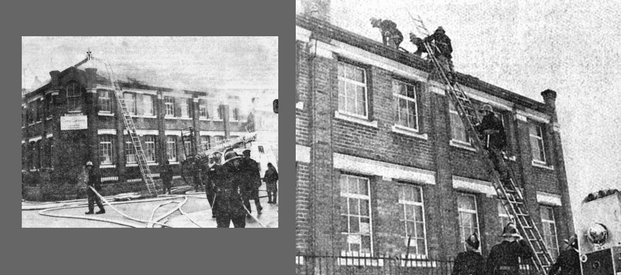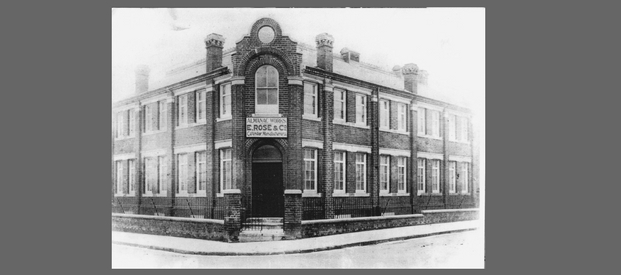Rising From The Ashes
 Exactly fifty five years ago this year, fire destroyed much of the Rose factory where it was located in the centre of Colchester. At the time it was a disaster, but it sparked a decade of development at the family business with regeneration and innovation following ever since.
Exactly fifty five years ago this year, fire destroyed much of the Rose factory where it was located in the centre of Colchester. At the time it was a disaster, but it sparked a decade of development at the family business with regeneration and innovation following ever since.
Fire!
It was Miss Edna Winterflood who raised the alarm. Edna was a loyal employee who had worked for Rose of Colchester for many years, since joining the firm at the age of 14. She was alone in the Kendall Road factory on Saturday 24 February 1962 when, just after noon, she saw smoke rising from the works. She immediately called the fire brigade and then bravely gathered up all the precious records she could carry, and removed them from the building, saving them from burning.
Fire fighters battled against the blaze while police evacuated people from the houses closest to the burning factory. Eventually, after a struggle of an hour and forty minutes the fire was under control, but by then serious damage had been done to both the factory building and its contents.
The family business
At the time of the fire, Ivor Rose was running the thriving business with his two sons, Richard (known as Dick) and Chris. The firm already had a pictorial range of calendars but at that time Rose of Colchester was best known for its bold figure and memo calendars which were a familiar sight on the walls of offices and businesses all over Britain.

The firm had been operating from Kendall Road, Colchester since 1910, in premises originally built in 1881 as a boot and shoe factory. Much of this handsome building was damaged in the fire and many of the colour blocks used for the calendar pictures were destroyed too.
After such a serious setback, while parts of the factory were rebuilt, the firm carried on production in rented premises and Ivor, Dick and Chris began to rebuild the business. With hard work, new ideas and investment, they worked tirelessly to make sure that in its recovery the family firm became stronger than ever.
Quality and speed: a decade of new investment
The first major improvement was to the quality of printing, brought about by the purchase in 1964 of new hot metal slug setting. In the past, typesetting had been from single type in a case, hand-set in a composing stick, using type which was ‘dissed’ back into the case for use again. With this new method, the type was created from new each time, giving much sharper results.
Next, the speed of production was improved. With fast new letterpress printing machines and sheet-fed rotary letterpress machines, production doubled from 3,000 to 6,000 sheets per hour. The new Thomas Gathermatic Collator also saved time with its fast and automatic assembly of printed sheets into sets for each calendar.
In 1971 the company purchased its first offset litho machine – a single colour Heidelberg Kord – and work on this machine soon progressed from two-colour work to four-colours. The high quality of its printed illustrations meant the company could compete more favourably for better quality work and attract a better quality market.
In the decade following the fire, thanks to new ideas and investment, Rose of Colchester flourished so that by the mid-70s the sales team, which ten years earlier had numbered 40 people, had grown to 75 agents promoting the business throughout England, Scotland, Ireland and Wales.
The business continues to thrive and continues to sell promotional business calendars through a network of sales agents covering the whole of the UK.









